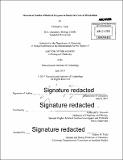Structural studies of radical enzymes in bacterial central metabolism
Author(s)
Funk, Michael A. (Michael Andrew)
DownloadFull printable version (34.99Mb)
Other Contributors
Massachusetts Institute of Technology. Department of Chemistry.
Advisor
Catherine L. Drennan.
Terms of use
Metadata
Show full item recordAbstract
Anaerobic bacteria play a crucial role in cycling of nutrients in diverse ecosystems, degradation of organic compounds, and as key members of the human gut microbiome. The absence of oxygen limits the chemistry that bacteria can perform; however, these organisms do make use of organic radical cofactors that are oxygen sensitive. This thesis presents a structural analysis of three enzymes that utilize a glycyl radical cofactor to perform difficult, radical-based chemistry. Benzylsuccinate synthase catalyzes the first step in the anaerobic degradation of toluene, a major component of gasoline and an environmental pollutant. Choline trimethylamine-lyase is used by gut bacteria to degrade choline, producing a byproduct, trimethylamine, which is linked to human diseases. These two enzymes share a common protein fold and also utilize a similar series of steps to initiate chemistry on their substrates. However, once they have generated a radical intermediate, the enzyme active site guides very different chemical steps in these two enzymes. Class III ribonucleotide reductases catalyze the same chemical reaction as observed in aerobic or oxygen independent systems, but utilize a glycyl radical cofactor to initiate chemistry. X-ray crystal structures have given us snapshots of these enzymes in action and accompanying biochemical experiments are help reveal the mechanisms they use to control radical chemistry. These structures have highlighted the potential diversity of chemical reactions available to anaerobic organisms through the use of a conserved enzyme fold.
Description
Thesis: Ph. D. in Biological Chemistry, Massachusetts Institute of Technology, Department of Chemistry, 2015. Vita. Cataloged from PDF version of thesis. Includes bibliographical references.
Date issued
2015Department
Massachusetts Institute of Technology. Department of ChemistryPublisher
Massachusetts Institute of Technology
Keywords
Chemistry.